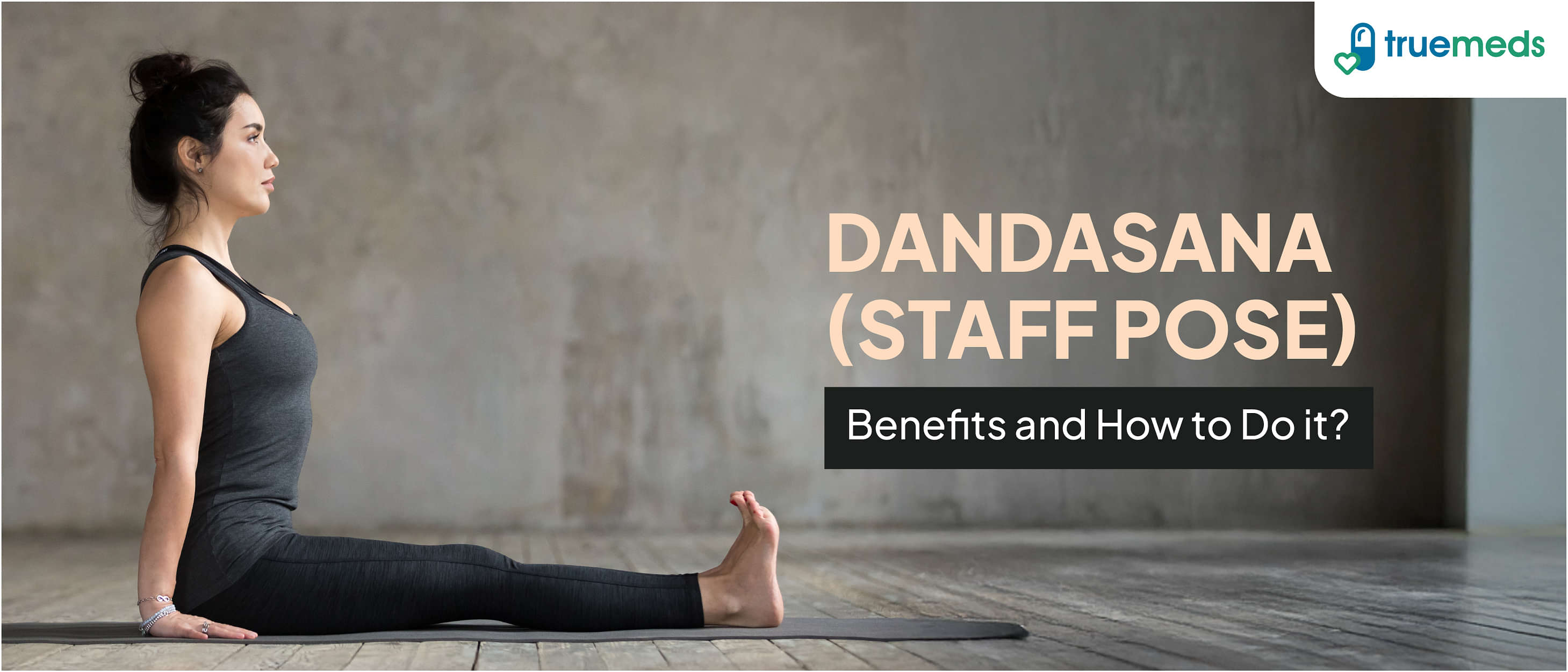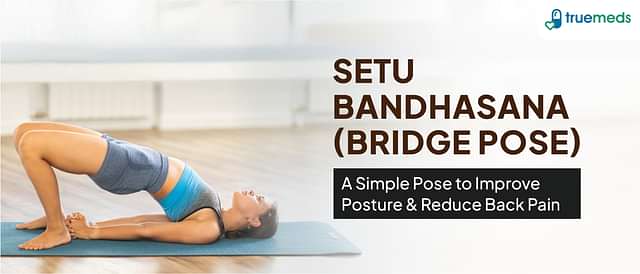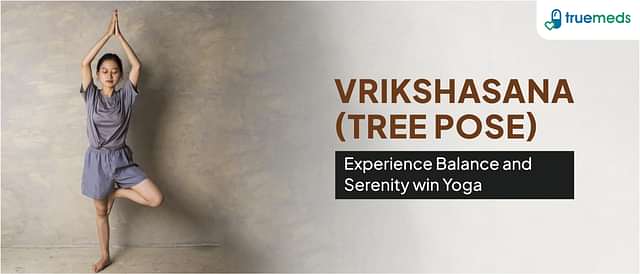Benefits of Dandasana (Staff Pose) and How to Do It
Last updated on : 08 Oct, 2024
Read time : 7 min
Introduction
Let us introduce you to Dandasana, also known as the Staff Pose, the perfect pose to get you started on your journey to equilibrium and strength. A cornerstone of any yoga routine, this seated pose enhances posture and serves as a springboard to more advanced asanas. By engaging your core and aligning your spine, Dandasana cultivates awareness and prepares you for more complex poses. Whether you are a beginner or an experienced yogi looking to strengthen your practice, incorporating Dandasana into your routine can significantly improve your physical and mental well-being.
What is Dandasana?
Originating from the Sanskrit words “danda” (staff) and “asana” (pose), Dandasana is a seated yoga position that emphasises proper alignment and posture. Often considered the starting point for various seated asanas, this pose requires practitioners to sit with their legs extended straight in front, feet together, and back upright. The body in this pose resembles a staff – thus the name ‘Staff Pose’.
Dandasana works wonders in strengthening the spine and core muscles, improving flexibility in your hamstrings, and enhancing overall body awareness. Regular practice of this pose can lead to improved posture and reduced back pain, reflecting why it has turned out to be an essential component of any yoga routine.
How to Do Dandasana?
Dandasana requires attention to both your breath and body alignment. Here’s a simple step-by-step procedure on how to do it:
- Start by sitting comfortably on the floor. Extend your legs straight in front of you. Keep your feet together.
- Flex your toes towards your body. This action will engage the muscles in your legs.
- Place your hands on the floor beside your hips with your fingers pointing forward.
- Engage your core muscles – this is the area surrounding your abdomen and spine.
- Lengthen your spine as if a string is pulling you up from the crown of your head.
- Draw your shoulders back and down, away from your ears. This action will open up your chest area promoting better breathing.
- Ensure that your head is aligned with your spine, not leaning forward or backwards.
- Hold the pose for several breaths, focusing on maintaining a straight back and relaxed shoulders.
- To deepen the stretch, you can gently hinge forward at the hips whilst keeping the spine elongated.
| Did You Know? The staff in Dandasana represents the spinal column, which should be straight and strong, much like the staff carried by Indian renunciates (sadhus/swamis) known as “swami danda”. This pose is not only integral to Hatha Yoga but also acts as a preparatory posture for more advanced practices, helping to improve flexibility and strength in the legs and back. |
Benefits of Dandasana (Staff Pose)
Dandasana offers a multitude of benefits for both the body and mind, enhancing overall well-being.
Here are the benefits of Dandasana (Staff Pose):
1. Benefits of Dandasana for Fatigue and Balance
Feeling fatigued? Dandasana might be what you need! This pose promotes relaxation and grounding, helping combat fatigue. It encourages proper alignment and body awareness, which in turn enhances balance.
2. Benefits of Dandasana for Regulating Blood Pressure
If you are looking to regulate blood pressure, Dandasana could be beneficial. It promotes relaxation and lowers stress, key factors in regulating blood pressure. The deep breathing encouraged by the pose activates the parasympathetic nervous system, helping lower heart rate and blood pressure.
3. Benefits of Dandasana for Managing Stress
In today’s fast-paced world, stress management is crucial. Dandasana can be an effective tool for managing stress. It encourages mindfulness and breath control, promoting a sense of calm and grounding.
4. Benefits of Dandasana for Cancer
Dandasana can also be beneficial for individuals battling cancer. It promotes physical strength and mental clarity, key aspects of wellbeing during challenging times such as these. Regular practice may also foster a deeper connection between the mind and body, empowering individuals to manage their health journey with greater confidence.
5. Benefits of Dandasana for the Heart
This pose supports heart health by encouraging proper posture and blood circulation. It opens up the chest area, promoting deep breathing which can enhance oxygen intake and thus improve overall cardiovascular function.
6. Benefits of Dandasana for Improving Posture
With working from home becoming a norm, maintaining a good posture has become more important than ever. Dandasana can help in improving posture by emphasising spinal alignment and core engagement.
7. Benefits of Dandasana for Osteoarthritis
Last but not least, for individuals dealing with osteoarthritis, Dandasana can provide gentle relief and promote joint flexibility. The seated position allows for a safe stretch, helping alleviate stiffness in the legs and hips. Practicing Dandasana encourages proper alignment which can reduce strain on the joints.
Risks of Dandasana
Practitioners need to exercise caution, especially if they have existing wrist, back or shoulder injuries. This is because any incorrect posture or alignment during the Dandasana procedure can exacerbate these conditions.
Individuals with high blood pressure or those who have recently had surgeries should avoid this pose until they get the green light from their family doctor. It’s crucial to remember that if you experience discomfort or pain while practising Dandasana steps, you should immediately stop and reassess your form. Continuing despite discomfort can lead to potential injuries which are best avoided.
For your safety and to achieve proper technique, consider practising under the guidance of a qualified instructor. They can help you understand the correct alignment and modifications of the pose, ensuring that you get the most benefits from Dandasana while minimising risks.
Conclusion
To wrap things up, Dandasana, also known as Staff Pose, is far more than just a simple sitting posture in yoga. It is a foundational exercise that comes with a plethora of benefits. The practice of Dandasana offers benefits such as improved posture and balance, promoting relaxation and efficient stress management. This pose serves as a powerful tool for maintaining your overall well-being.
However, like any other exercise, it’s essential to perform the Dandasana steps with awareness and caution, particularly if you have any pre-existing conditions. Yet, the rewards of incorporating this pose into your daily routine can be highly significant.
Dandasana fosters mindfulness and body awareness, which not only strengthens the body but also nurtures the mind. This makes it an invaluable addition to anyone’s yoga practice. So why not embrace this posture and experience its transformative effects yourself?
FAQs
Dandasana, also known as the staff pose, can be practised by sitting on the floor with legs stretched forward, keeping your spine straight and hands resting beside your hips.
Individuals with lower back ailments or wrist injuries should avoid practising Dandasana. Pregnant women should also refrain from this posture.
Begin in a seated position with legs extended in front. Tuck in your abdomen, engage your thigh muscles and ensure your hands are resting flat on the floor beside you.
To perform Dandasana, sit straight on the floor, stretch your legs forward, flex your feet and place your palms on the floor. Breathe in deeply and hold the posture while maintaining a steady gaze.
The potential benefits of Dandasana include improved posture, increased core strength, better digestion, and relief from sciatica pain. Regular practice can also enhance body awareness.
Disclaimer
Our healthcare experts have carefully reviewed and compiled the information presented here to ensure accuracy and trustworthiness. It is important to note that this information serves as a general overview of the topic and is for informational purposes only. It is not intended to diagnose, prevent, or cure any health problem. This page does not establish a doctor-patient relationship, nor does it replace the advice or consultation of a registered medical practitioner. We recommend seeking guidance from your registered medical practitioner for any questions or concerns regarding your medical condition.
Popular Articles
Recommended Articles
Recent Articles
Top-Selling Medicines:
...View more
Top-Selling OTC:
...View more
Company
About UsHealth ArticleHealth StoriesDiseases & Health ConditionsAll MedicinesAll BrandsNeed HelpFAQSubscribe
Registered Office Address
Grievance Officer
Download Truemeds

Contact Us
Our customer representative team is available 7 days a week from 9 am - 9 pm.
v3.7.8
Our Payment Partners



























































